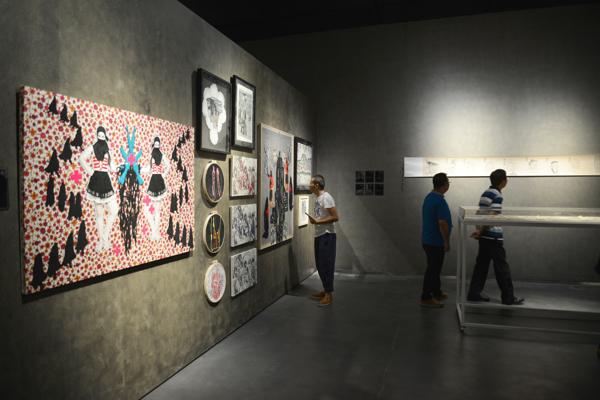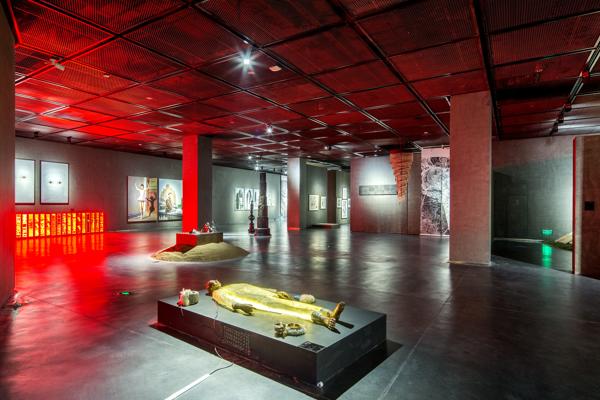
Visitors at the ongoing exhibition Dimension of Civilizations at MOCA Yinchuan in the Ningxia Hui autonomous region.[Provided to China Daily]
China’s barren Ningxia may seem an unlikely place for a contemporary art museum, but MOCA Yinchuan hopes its unusual location will serve as an intersection of two cultures.
Ever since the first brick was laid, debate has swirled around MOCA Yinchuan, with many people questioning if the underdeveloped Ningxia Hui autonomous region in China’s barren northwest is the best place for a contemporary art museum.
The museum finally showed its face to the world with a grand opening on Aug 8. The museum promises to rejuvenate the cultural glory of Yinchuan, a vital crossing point on the ancient Silk Road.

A hall of MOCA Yinchuan features contemporary art pieces including an installation inspired by unearthed jade clothing sewn with golden thread from a Han Dynasty (206 BC-AD 220) tomb.[Provided to China Daily]
MOCA Yinchuan is located in a half-built art district on the western bank of the Yellow River, far away from the Yinchuan city center. It is surrounded by an idyllic backdrop of rice paddy fields and wetlands.
The museum covers 15,000 square meters. Its innovative architecture imitates the geological fold commonly seen on the rocks and mountains along the Yellow River.
In its heyday, Yinchuan served as a gateway for nomads and Arab merchants to the Middle Kingdom. It has long been an intersection of multiple cultures and today, a quarter of its population are Hui people, a predominantly Muslim ethnic group.
MOCA Yinchuan aims to be a platform to demonstrate and study the connection between Islamic and Chinese civilizations. It is dedicated to providing brand-new channels of communication for Eastern and Western cultures.

[Photo/China Daily]
The museum spells out its mission in it’s inaugural exhibition. Called, Dimension of Civilizations, the exhibition features 200 oil paintings, 70 antique maps and hundreds of contemporary Chinese and Islamic artworks.
Lyu Peng the chief curator and an art historian, says the show presents “different perspectives to observe the dimension of different civilizations”. He says the juxtaposition of Chinese and foreign artworks enables viewers to “compare the common aspects shared by cultures and the differences still so obvious today”.
Lyu curated a section of late Qing Dynasty (1644-1911) oil paintings, which were created by foreigners in Canton (today’s Guangzhou) and their Chinese students. The canvasses capture the landscape, local customs and daily life in China and became popular souvenirs among foreign businessmen and travelers. Such paintings are often referred to as “exported paintings”.
Lyu says these paintings are not simply commodities, but are a disappearing chapter of Chinese art history.

[Photo/China Daily]
Giuseppe Castiglione is widely recognized as an important figure who introduced oil painting to Chinese emperors and the nobility. Lyu says the “exported paintings” are testament to the way ordinary Chinese embraced Western realistic art.
Many paintings on show are rarely displayed, even in museums in Beijing and Shanghai. Of note, are the works of British painter George Chinnery and his Chinese student Lam Qua. Lam mastered the technique of painting British landscapes and developed a highly personal style, becoming the first Chinese portrait painter exhibited in the West.
A section called, Between the East and West, features multimedia creations by Chinese artists who grew up in the country’s western part, and artists from Arab nations. These works do not represent the Islamic world through symbolism, but rather explore the deeper side of Islam through artists’ personal experiences.
Yinchuan will host the China-Arab States Expo 2015 from Sept 10-13, so a special section is dedicated to contemporary art from Jordan, which is the guest country of honor at the fair.
Also on show are 1,000 cloth dolls, a traditional handicraft from northwestern China, made by local families. The display is part of the museum’s efforts to connect with local communities through art education programs.
Suchen Xie, former director of Beijing’s Today Art Museum and now MOCA Yinchuan’s artistic supervisor, says it is important to link art with local’s daily life.
“The doll show isn’t academic at all. But it makes people feel involved - people made the dolls and can touch them. Isn’t that what contemporary art should embrace?” she says.
MOCA Yinchuan can pave a modern Silk Road of contemporary art between the East and West, but concerns over its ability to do so, still remain.
Lyu’s responds to such concerns with a plea to consider the bigger picture: “The process of globalization has changed how people define things. The so-called ‘center’ and ‘periphery’ no longer exist in a digital age. Anyone or any place can be the focus as long as they are good enough.”
The show will run through Dec 6.
